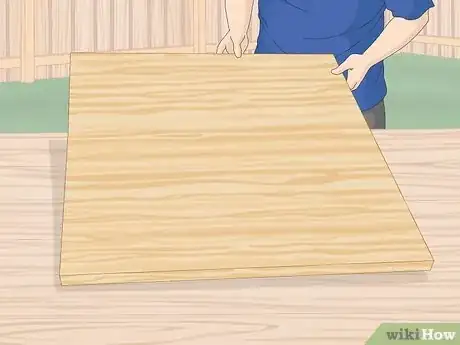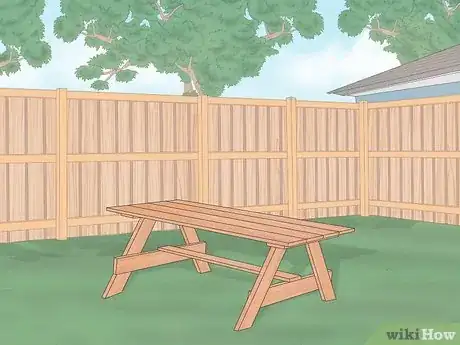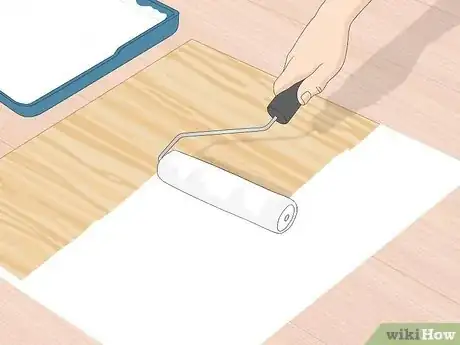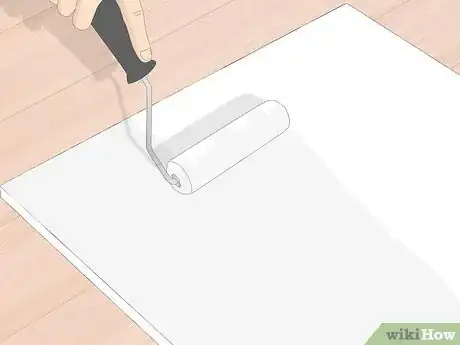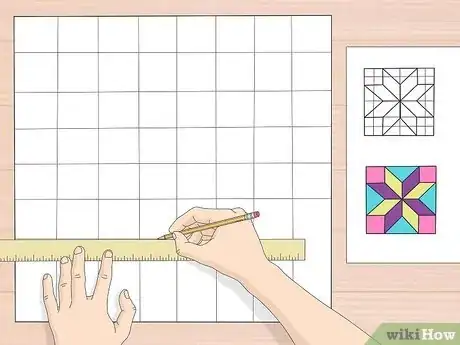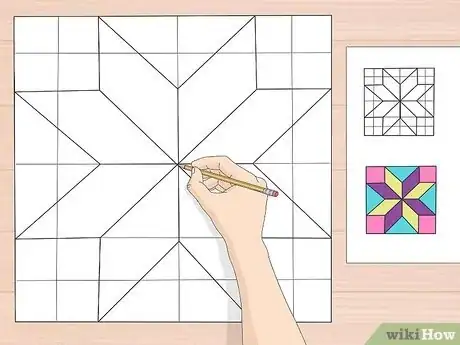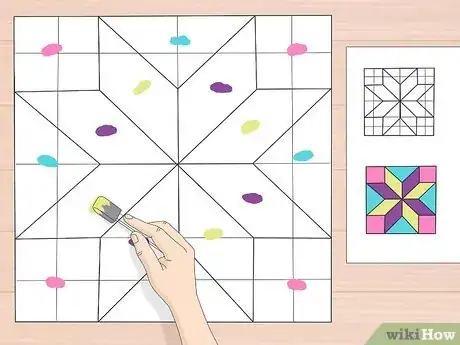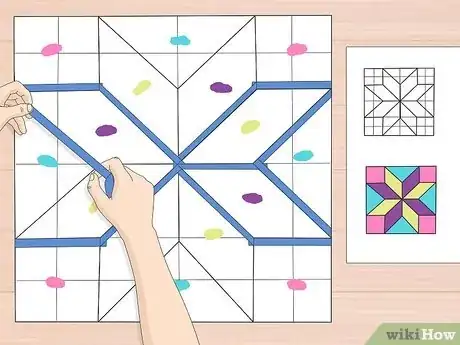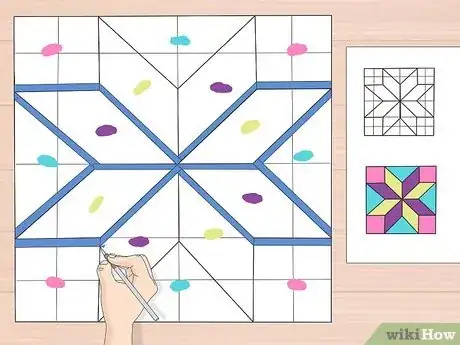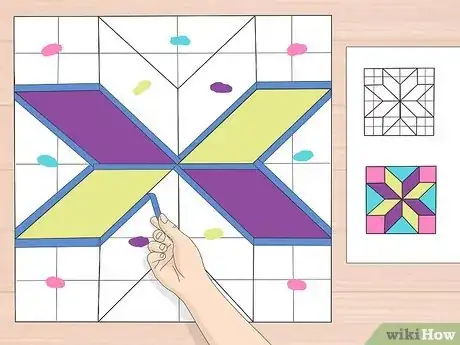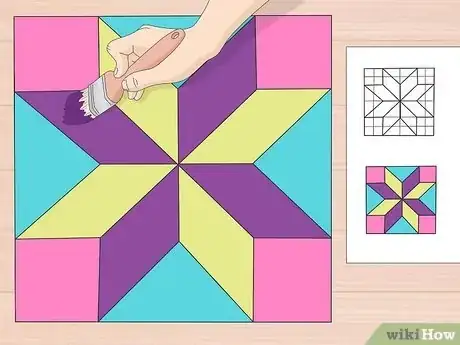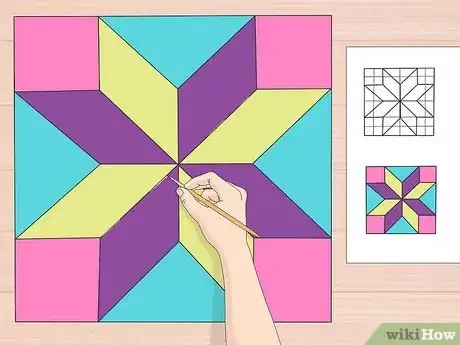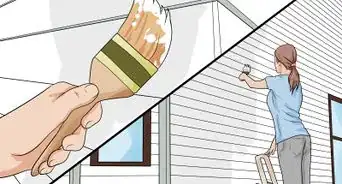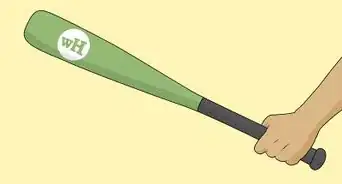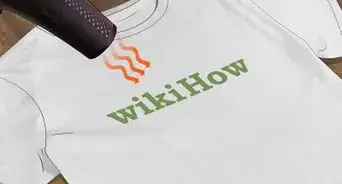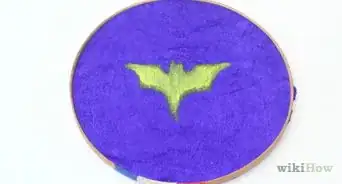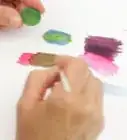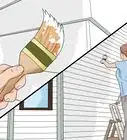This article was co-authored by Jeff Baldwin. Jeff Baldwin is a Residential Painter and the Owner of Baldwin Custom Painting. With two decades of painting experience, Jeff specializes in high-end residential and small commercial painting projects. Dedicated to quality craftsmanship, Jeff and Baldwin Custom Painting provide bonded/insured, licensed, and lead-safe certified services in residential painting, light commercial painting, and wood refinishing.
There are 12 references cited in this article, which can be found at the bottom of the page.
wikiHow marks an article as reader-approved once it receives enough positive feedback. This article received 25 testimonials and 92% of readers who voted found it helpful, earning it our reader-approved status.
This article has been viewed 457,404 times.
A barn quilt is a quilt block pattern painted onto a square of plywood. You don’t have to have a barn to make one – you can put your finished project anywhere you like. Barn quilts are a fun craft project to do with friends. To make your barn quilt, prime the wood, block out your pattern, and paint the design with the help of painters tape.
Steps
Priming the Wood
-
1Buy a square of smooth, pressure-treated plywood. Since you will be painting on your plywood, you want it to have a smooth texture. Signboard is a great option, but if you can’t get it, sanded plywood or medium-density fiberboard will also work.
- A common size is 4 by 4 feet (120 by 120 cm), but you can make your barn quilt whatever size you want. A smaller one is an easy way to start.
- A lumberyard or a home supply store are good places to look for plywood.
-
2Work in a well-ventilated spot and protect the floor with drop cloths. Do your priming and painting outside or in an open garage. Lay down drop clothes to protect the floor if you are painting on the ground. You can also put your plywood on top of sawhorses or on a work table.[1]
- If you don’t have ventilation when you paint, the paint fumes can be really harmful.
Advertisement -
3Apply exterior latex primer to the plywood with a roller. Pour primer into a rolling tray, and dip your paint roller into it. Rub the paint roller along the plywood in smooth, even strokes.[2]
- It’s important to use an exterior primer, since barn quilts are normally hung outdoors.
- You could also use a stain-blocking primer that bonds well. White-pigmented shellac is great because it stain blocks, goes on smoothly, dries quickly, sands easily, and locks in odors.
-
4Let the primer dry and apply a second coat. Allow the coat to dry, following the instructions on the primer. Different kinds of primer will take different amounts of time to dry, so check the instructions on your can of primer to figure out how long you need to let it sit. Then paint on the second coat just as you did the first one.
- Let the primer dry again.
-
5Paint 3 coats of primer on the back (rough) side. You need to prime the back of your board as well, even though you won’t be painting it. This helps keep your artwork waterproof, since the barn quilt will have to withstand the weather outdoors.[3]
- Be patient and wait for the primer to dry in between each coat. It will help your quilt last much longer.
Blocking Your Pattern
-
1Choose a simple quilt square pattern by looking at books or online. Search online for inspiration for barn quilt designs or fabric quilt designs. A quilt square with a simple geometric design made out of straight lines will be the easiest to paint on your barn quilt. You can also create your own simple design.[4]
- Bright, high-contrast designs look best on barn quilts.[5]
- The fewer colors you use, the quicker you’ll be able to paint the quilt. You might want to start with a simple, 3-color design.
-
2Sketch a grid onto your plywood with the same number of squares as the quilt block. Quilt blocks are usually 3x3 or 4x4 grids. Use a measuring tape and a straightedge to draw the right size grid onto your plywood.[6]
- One way to make sure that your gridlines are at right angles is to use a piece of printer paper to check the corner.
- An easy way to find the center of your board is to draw 2 diagonal lines across connecting the corners. The point where the lines cross is the center.
-
3Transfer your design onto the board in pencil. Match up lines on the quilt block with the grid squares on your plywood to help you enlarge the pattern. Use a ruler or another form of straightedge to help you draw straight lines.[7]
- Step back from the board every now and then to check that you’re transferring the pattern correctly. It’s easy to get caught up in the details and not realize you’re off by a whole row.
-
4Label each section with its color. To label, you can write the paint color in pencil or use a colored post-it to designate which color paint goes where. You can even put a little dab of paint of the right color in the section.[8]
- This will really help you out when you are applying the paint, because it’s easy to get confused.
Taping and Painting the Wood
-
1Put painters tape around the sections for your lightest color. Apply painters tape in a straight line along each edge of the sections where you will paint your lightest color. The inner edge of the painter’s tape should be lined up with the pencil outline of that color. Painters tape will easily peel off once you’re done with it. It’s best to start with your lightest color and work your way up to the darker colors.[9]
- The tape helps you paint smooth, straight lines.
- Make sure the tape is tightly attached to the plywood.
-
2Cut corners and points in the tape with a razor. If you have 2 overlapping pieces of painters tape at a corner, you can cut them away to make a sharp point. Line up your straight edge where you want to make the cut and cut the tape with a razor blade or x-acto knife. Then, peel off the bit of tape you sliced to reveal a sharp corner.[10]
- Be very careful with the blade. If you are a kid, get an adult to help with this step.
-
3Paint 2 coats of paint in the taped off sections. Use an exterior latex paint. Paint inside the tape lines for all the sections that are in your first color. You can use a paintbrush, a paint roller, or even a makeup sponge to apply the paint. Paint right up to the tape line and a little bit on top of the tape. That way, you’ll have a crisp, full block of color.[11]
- You don’t have to wait for your paint to totally dry before giving it a second coat– just leave it for a few minutes.[12]
-
4Peel off the tape immediately after applying the second coat. You should peel off the tape while the second coat of paint is still wet, so that it leaves behind a smooth line. Peel slowly and carefully to avoid smudging.[13]
- Don’t worry if there are a few spots where the paint bled through the tape, because you will touch up those spots at the end.
- Remember to let the paint dry thoroughly before you put more tape down.
-
5Let the first color dry completely. It may take about an hour or more for your paint to dry, so leave your barn quilt be and go do something else to keep yourself occupied. It’s really important to wait for the first color to dry completely, because if you tape over wet paint it will smudge.[14]
- Tap the paint lightly with your finger to check if it’s dry.
- If you are in a humid place, it will take even longer for your paint to dry.
-
6Continue taping and painting until you’ve finished the pattern. Remember to be patient and let each paint color dry thoroughly before moving onto the next color. Use a fresh paintbrush for each color.
- Remove the painters tape when you’ve done your last color and admire your work.
-
7Touch up mistakes with an artist’s paintbrush. There will probably be a few small spots where one color accidentally bled over onto the other color. Using a small artist’s paintbrush, cover up the mistakes with a little bit of the correct color.[15]
- Putting your pinky down helps keep your hand steady as you paint.
- If you don’t trust your freehanding skills, you can also put a bit of painters tape down on the line you want to fix.
Community Q&A
-
QuestionCan I use clear exterior varnish?
 Community AnswerNo, this would not be a good idea. Clear varnish usually shortens the length of time your barn quilt will look good by either weathering off or yellowing.
Community AnswerNo, this would not be a good idea. Clear varnish usually shortens the length of time your barn quilt will look good by either weathering off or yellowing. -
QuestionShould an exterior polyurethane be applied?
 Community AnswerNo. Polyurethane will wear off or discolor. It usually shortens the length of time your block looks good.
Community AnswerNo. Polyurethane will wear off or discolor. It usually shortens the length of time your block looks good. -
QuestionHow do I hang a barn quilt on a 4' X 4' foot pole barn?
 Community AnswerUsing quarter or half-inch plywood, use 1 1/4" self tapping stainless screws long enough to go through barn siding. Use a small-headed hex-head screw about every two feet all around the board. If you're going through steel siding, use stainless steel cap screws on some of the mountings, about half, with nuts and washers, if accessible on the inside.
Community AnswerUsing quarter or half-inch plywood, use 1 1/4" self tapping stainless screws long enough to go through barn siding. Use a small-headed hex-head screw about every two feet all around the board. If you're going through steel siding, use stainless steel cap screws on some of the mountings, about half, with nuts and washers, if accessible on the inside.
Things You'll Need
- High grade, pressure-treated plywood square
- Exterior latex primer
- Exterior latex paints in all the colors you need
- Painter's tape
- Straight edge
- Measuring tape
- Paint roller or brush
- Razor or X-Acto knife
- Small paintbrush
References
- ↑ https://www.cpsc.gov/s3fs-public/painting.pdf
- ↑ https://www.realsimple.com/home-organizing/home-improvement/painting/paint-wall
- ↑ http://theplywood.com/barn-quilts
- ↑ https://www.extension.iastate.edu/Documents/MCMS/flPlymouthCountyISUBarnQuiltDirections.pdf
- ↑ http://theplywood.com/barn-quilts
- ↑ https://youtu.be/6vf7K8Z8ihw?t=85
- ↑ https://www.extension.iastate.edu/Documents/MCMS/flPlymouthCountyISUBarnQuiltDirections.pdf
- ↑ https://www.extension.iastate.edu/Documents/MCMS/flPlymouthCountyISUBarnQuiltDirections.pdf
- ↑ https://www.extension.iastate.edu/Documents/MCMS/flPlymouthCountyISUBarnQuiltDirections.pdf
About This Article
to paint a barn quilt, which is a block pattern painted on a plywood board, start by applying 2 coats of primer to your wooden board to make your quilt more long-lasting. While you’re waiting for the primer to dry, pick the pattern you’ll paint by looking at ideas online or in books. Once you’ve decided on a pattern, sketch it onto your board with a pencil so you can see where to paint later. Then, apply painter’s tape around the sections where 1 of your colors will be used. Put 2 coats of paint on these areas, and tear of the tape immediately after the second coat so the paint dries in a straight line. Wait until the first color has dried completely before taping and painting the areas for the other colors in the same way until your project is complete. For tips on how to select the best kind of wood for a barn quilt, keep reading!
